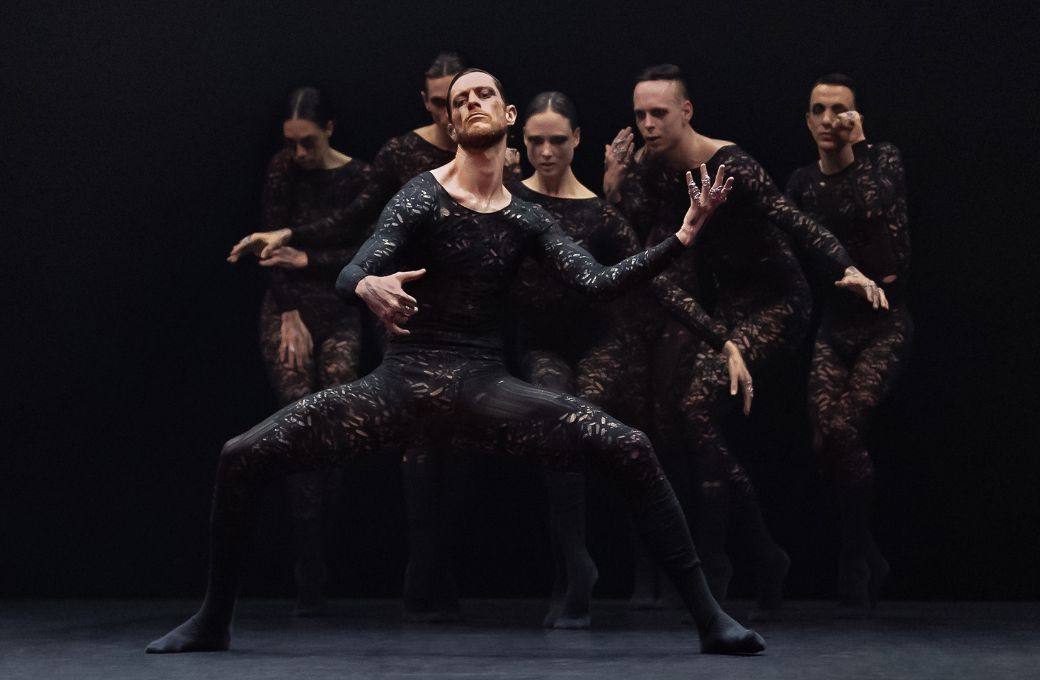Sharon Eyal and Gai Behar’s Into the Hairy has landed at Sadler’s Wells, attracting a wildly enthusiastic audience in a packed house. I say ‘landed’ because her dancers, wherever they are from, in this case her own French company S-E-D, always look as if they are creatures from another world.

Into the Hairy premiered at Montpellier Danse in 2023 and is a collaboration between Eyal, Gai Behar and composer Koreless (Welshman Lewis Roberts). With costume designs by Maria Grazia Chiuri of Christian Dior Couture and Alon Cohen’s always excellent lighting, those of us familiar with Eyal’s work knew roughly what to expect.
Eyal’s choreography is unmistakable: the clusters of bodies, teetering for the duration of the piece on a high demi-pointe, distorted torsos, jerks and twitches and such physical intensity that one feels sucked into the whole experience. In this sense, Into the Hairy felt like tried and tested territory. Yet as soon as the curtain rose, I was transfixed.
It started with sounds of dripping water, gradually getting louder, some singing and the wrenching of some form of machinery. The dancers, adorned in dark and exotic bodysuits, every ripple and contour visible, wore ghoulish but fantastical make-up. Initially, like much of Eyal’s work, the movements were minimal, but throughout the 45 minute piece, the tension increased, limbs suddenly flew up, dancers broke free from the group. It was impossible to lose focus. It was like being trapped in some kind of febrile, involuntary escapade.
While one might seek to find a theme in this abstract work, it was emotional, instinctive and gut feelings that supplanted any reasonable whisper of following a logical concept. There were some symbolic moments – a man with outstretched arms, surrounded by the group, hinted at the crucifixion. At one point, the dancers gathered around a woman inching forward who had a man’s forearm and clenched fist thrust between her legs. An aggressive visual that could imply unwanted male intrusion or that she was the one in control, making sure that her thighs, in a vice-like grip around his arm, prevented any unwanted developments.
Sections where the dancers followed one another or faced the audience in a straight line were particularly impressive, precariously oscillating until the tiniest head movement redirected attention. Mostly it was their synchronicity that ensured we remained as invested as the cast. The slightly surreal swarm effect that is a signature of Eyal’s choreography never abandons the stage. She claims that she never wants her dancers to feel comfortable, that she wants to see the inner and outer struggles. In this, she succeeds.
This was not pretty dance, nor aesthetically pleasing but there was a hypnotic, visceral quality to the movements, even when lines were broken and distorted. The element that I find most fascinating about Eyal’s work is what she manages to extract from her dancers. The precision and effort that each of them gives to every phrase, is frankly astonishing. You feel the physical exertion, the emphasis on detail, the fierce concentration and it’s all consuming.
If one exits the theatre feeling unsure about the meaning of the work, it doesn’t seem to matter. It is an offering of a different kind and a thought provoking one. It felt a little sinister at times, threatening even with the staring faces, the sequences of repetitive, regimented and ritualistic movements.
Eyal is an acquired taste but there is no doubt that anyone watching will feel compelled to stay put, even if it’s not what you expected. The highest praise must go to the company of eight dancers who were breathtaking for all the right reasons: their commitment and embodiment of the demands of such extreme choreography. Go and enjoy being completely saturated in Eyal and S-E-D for just 45 minutes.


